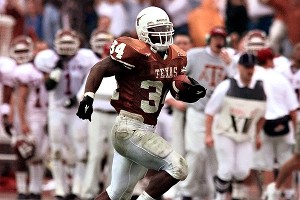By Ivan Maisel
ESPN.com
ESPN.com
The intellect will tell you that rivalries cannot die because they do not live. There is no pulse, no emotion, no feeling. A rivalry is a thing.
The heart will tell the intellect to take a walk.
[+] Enlarge

AP Photo/Eric GayRicky Williams shattered the all-time NCAA rushing record against the Aggies.
What can you say about a 117-year-old rivalry that died? That it was beautiful. And brilliant.
That it loved "The Aggie War Hymn" and the "Theme from 'Patton.'" And "The Eyes of Texas."
Texas and Texas A&M first played football in 1894, when a game consisted of two 35-minute halves. They first played on Thanksgiving Day in 1900, when a field goal earned five points. They will last play on Thanksgiving Day, in all likelihood for the foreseeable future, in 2011.
The rivalry between the state university and the agricultural school has been made flesh on football fields in state after state. But in few places did it engender the pride and passion and even playfulness that it did in the state of Texas.
And now that has been traded in for a pouch of magic SEC beans. At least that's what Texas fans say when they sneer at Texas A&M. Or it has been sacrificed as an offering to Mammon, if you ask the Aggies.
They got tired of competing on a playing field where everything tilted toward Austin.
The intellect will tell you that the rivalry is not dead because it can be restarted. Perhaps death is not as accurate as divorce. The end of the Texas-Texas A&M rivalry is a divorce of two parties that refuse to move as much as one inch toward halfway.
No, wait, that's not a divorce. That's Congress. Grown-ups in College Station and Austin, as in Washington, live behind the lines they drew in the sand. The Aggies are fleeing to the Southeastern Conference for financial security and respect. The Longhorns don't deign to miss them.
Former Texas head coach David McWilliams, who runs the association of former Longhorn players, said his members "don't really have a broad opinion of 'Screw 'em!' It's more like, 'Naw, I wouldn't play 'em.' It becomes a recruiting issue."
In the end, both sides ended the rivalry as a business decision, which is so not how the Aggie-Longhorn rivalry thrived for then a century. It always had a sense of playfulness, of college men pulling pranks because that's what college men do.
In 1916, Texas fans decided to brand their Longhorn mascot with the score of the Texas victory over the Aggies that season, 21-7. Texas A&M fans caught wind of the idea and drove down from Waco to brand the steer with the score of the Aggies' 13-0 victory in 1915. The Texas fans cloaked the Aggie brand by changing 13-0 to BEVO, and a mascot underwent its christening. By fire, actually.
Without the Longhorns, the Aggies wouldn't have one of the great fight song lyrics in college sports. Every Aggie bellows "Goodbye to texas university," because Aggies do not consider it The University of Texas.
Without the Aggies and their "Gig 'Em" signal, a Texas student named Harley Clark wouldn't have come up with the "Hook 'Em" sign in 1955.
Without the Longhorns, the Aggies wouldn't have had Bonfire, both the decades of wonderful memories and the tragedy of its demise.
That's the thing. Texas A&M wouldn't be Texas A&M without Texas, and vice versa.
The Longhorns have beaten the Aggies by nearly a 2-to-1 margin (75-37-5, .662). That hasn't lessened the intensity between the two schools. Each has victories over the other pressed into its family bible.
[+] Enlarge

AP Photo/Pat SullivanThe two sides came together in times of tragedy, like the 1999 bonfire accident.
In 1957, Darrell Royal, the first-year coach of No. 15 Texas, used the quick kick early and often to outsmart Bear Bryant and No. 4 Texas A&M 9-7.
In 1963, the undefeated Longhorns' drive to the national championship nearly went off the trail against the two-win Aggies. Two fourth-quarter touchdowns secured a 15-13 victory, although Texas A&M fans maintain to this day that Jim Willenborg did notjuggle an interception in the end zone.
The Aggies dominated the rivalry in the 1980s, when quarterback Bucky Richardson led them to three consecutive victories. He was denied a fourth in 1990, his senior season, when Texas stopped a two-point conversion to win 28-27 and stay in the national championship race.
With one 60-yard touchdown run against the Aggies, Longhorns tailback Ricky Williams secured not only the NCAA career rushing record but the 1998 Heisman Trophy, as Texas upset the Big 12 South champions 26-24.
A year later, Texas A&M returned the favor, upsetting division-winning Texas 20-16. It may have been the only season when Longhorns fans didn't feel bad about losing to the Aggies.
When the bonfire stack collapsed days before, killing 11 Aggie students and one alumnus, the schools bonded with such raw emotion that both sides believed their relationship had been changed forever. Texas darkened the lights on its bell tower and refused to hold its "Hex Rally." Texas A&M responded by shelving its use of the cheer "Beat the Hell out of t.u."
After the Aggies won, Ray Bowen, then the president of the university, said of Texas, "They came to us in a way no one could have expected. We love them for doing that."
That was only 12 years ago. Texas and Texas A&M will leave Kyle Field on Thursday night and go their separate ways, two public institutions bound by their common dislike of one another. One of the oldest rivalries in college football has transformed into one of the oldest rivalries, period. Texas and Texas A&M have become Jacob and Esau.
Ivan Maisel is a senior writer for ESPN.com and hosts the ESPNU College Football podcast. Send your questions and comments to him at Ivan.Maisel@ESPN.com.
Follow Ivan Maisel on Twitter: @Ivan_Maisel

No comments:
Post a Comment